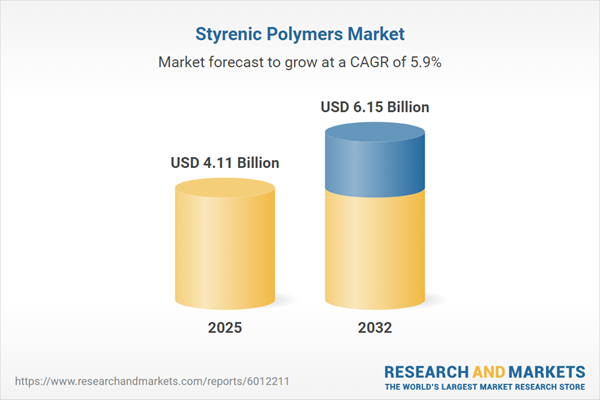Speak directly to the analyst to clarify any post sales queries you may have.
The styrenic polymers market is experiencing major shifts as evolving regulations and global supply trends reshape how industry leaders approach risk, resilience, and operational strategy. Senior executives increasingly evaluate opportunities to strengthen competitive positioning and adapt to changing industry requirements.
Market Snapshot: Styrenic Polymers Market Growth and Outlook
The global styrenic polymers market is expected to grow from USD 3.88 billion in 2024 to USD 4.11 billion in 2025, achieving a compound annual growth rate of 5.91%. By 2032, projections show the market reaching USD 6.15 billion. Expansion is driven by steady demand across automotive, packaging, electronics, and construction industries. These end-users seek high-performance, specialized materials, encouraging ongoing investment in both technology advancement and process improvements. Trends toward better recycling and greater sustainability are boosting adoption rates throughout the value chain, as stakeholders increasingly recognize the business value of responsible materials management. Regional differences continue to affect strategies: North America leverages advanced manufacturing; the EMEA region reacts to complex regulatory changes; and Asia-Pacific stands out for rapid production increases. Regional adaptation and supply-chain risk management remain top executive priorities.
Scope & Segmentation: Comprehensive Styrenic Polymers Market Analysis
This in-depth analysis offers clarity on core market aspects, guiding executive decision-making in the styrenic polymers sector:
- Polymer Types: Acrylonitrile Butadiene Styrene (ABS) is selected for applications that demand advanced thermal and electrostatic protection. General Purpose Polystyrene is key in packaging, healthcare, and food sectors due to its integration flexibility. High Impact Polystyrene enables product durability and enhanced transparency for specialized industrial needs.
- End-Use Applications: Automotive, construction, electronics, packaging, and consumer goods significantly contribute to market demand, evidencing the material’s broad adaptability and compliance with sector-specific standards.
- Industries Served: Original Equipment Manufacturers (OEMs), aftermarket providers, and end-to-end supply chain specialists in construction, electronics, consumer appliances, and packaging aim to achieve cost optimization, supply security, and customer-focused solutions.
- Manufacturing Processes: Both batch and continuous operations are utilized alongside bulk, emulsion, and suspension polymerization techniques. These approaches support product customization and progress toward sustainable manufacturing.
- Regional Coverage: Coverage includes the Americas, Europe, Middle East & Africa—spotlighting countries like the UK, France, and Germany—as well as Asia-Pacific regions such as China, India, Japan, and Southeast Asia. Analysis emphasizes regulatory diversity, procurement complexity, and regional supply chain approaches.
- Company Analysis: Industry leaders such as INEOS Styrolution Group GmbH, Trinseo LLC, Saudi Basic Industries Corporation, and LG Chem Ltd. are compared for investment focus and digital transformation, offering industry performance benchmarks.
Incorporating these dimensions enables executives to better identify new market opportunities, accelerate innovation, and realign their business models for both global and local success.
Key Takeaways: Styrenic Polymers Strategic Insights
- Styrenic polymers offer versatile technical benefits, supporting resilience and operational efficiency for manufacturers serving varied customer needs.
- Sustainable sourcing and increased recycling initiatives play a substantial role in minimizing operational risks and supporting responsible industry participation.
- Regionally concentrated production strategies and diversified supplier bases are helping organizations address both market volatility and procurement risks in key territories.
- Adoption of digital manufacturing technologies is driving shorter lead times, improved efficiencies, and flexible solutions tailored to changing customer and regulatory demands.
- Strong collaboration across the value chain enhances regulatory compliance, encourages innovation, and helps sustain competitive performance in core international markets.
Tariff Impact: United States Tariffs Shaping Market Strategies in 2025
Recent developments in U.S. tariff policy have prompted manufacturers to reassess procurement tactics and closely monitor supply costs. Strengthening relationships with domestic suppliers and establishing robust value networks are essential to mitigating supply continuity and security concerns amid shifting trade policies.
Methodology & Data Sources
The analysis is supported by direct interviews with senior executives, technical specialists, and sustainability experts. Supplementary materials include current regulatory documents, the latest market studies, patent databases, and peer-reviewed research, ensuring triangulated insights reflect B2B priorities.
Why This Report Matters
- Supports executive decisions around procurement, supplier engagement, and risk management as market and regulatory dynamics evolve.
- Delivers timely market intelligence to inform investments and sourcing plans within principal industry segments and global regions.
- Enables organizations to anticipate and address supply chain, technology adoption, and regulatory risks in strategic planning.
Conclusion
Technology advancements, active supply chain management, and rising regulatory standards continue to shape the styrenic polymers sector. This report delivers the insight senior leaders need to confidently guide strategic planning and unlock new business value.
Additional Product Information:
- Purchase of this report includes 1 year online access with quarterly updates.
- This report can be updated on request. Please contact our Customer Experience team using the Ask a Question widget on our website.
Table of Contents
3. Executive Summary
4. Market Overview
7. Cumulative Impact of Artificial Intelligence 2025
Companies Mentioned
The companies profiled in this Styrenic Polymers market report include:- INEOS Styrolution Group GmbH
- Trinseo LLC
- Saudi Basic Industries Corporation
- LG Chem Ltd.
- TotalEnergies SE
- Chevron Phillips Chemical Company LLC
- Braskem S.A.
- Versalis S.p.A.
- Formosa Plastics Corporation
- Shell plc
Table Information
| Report Attribute | Details |
|---|---|
| No. of Pages | 182 |
| Published | October 2025 |
| Forecast Period | 2025 - 2032 |
| Estimated Market Value ( USD | $ 4.11 Billion |
| Forecasted Market Value ( USD | $ 6.15 Billion |
| Compound Annual Growth Rate | 5.9% |
| Regions Covered | Global |
| No. of Companies Mentioned | 11 |









